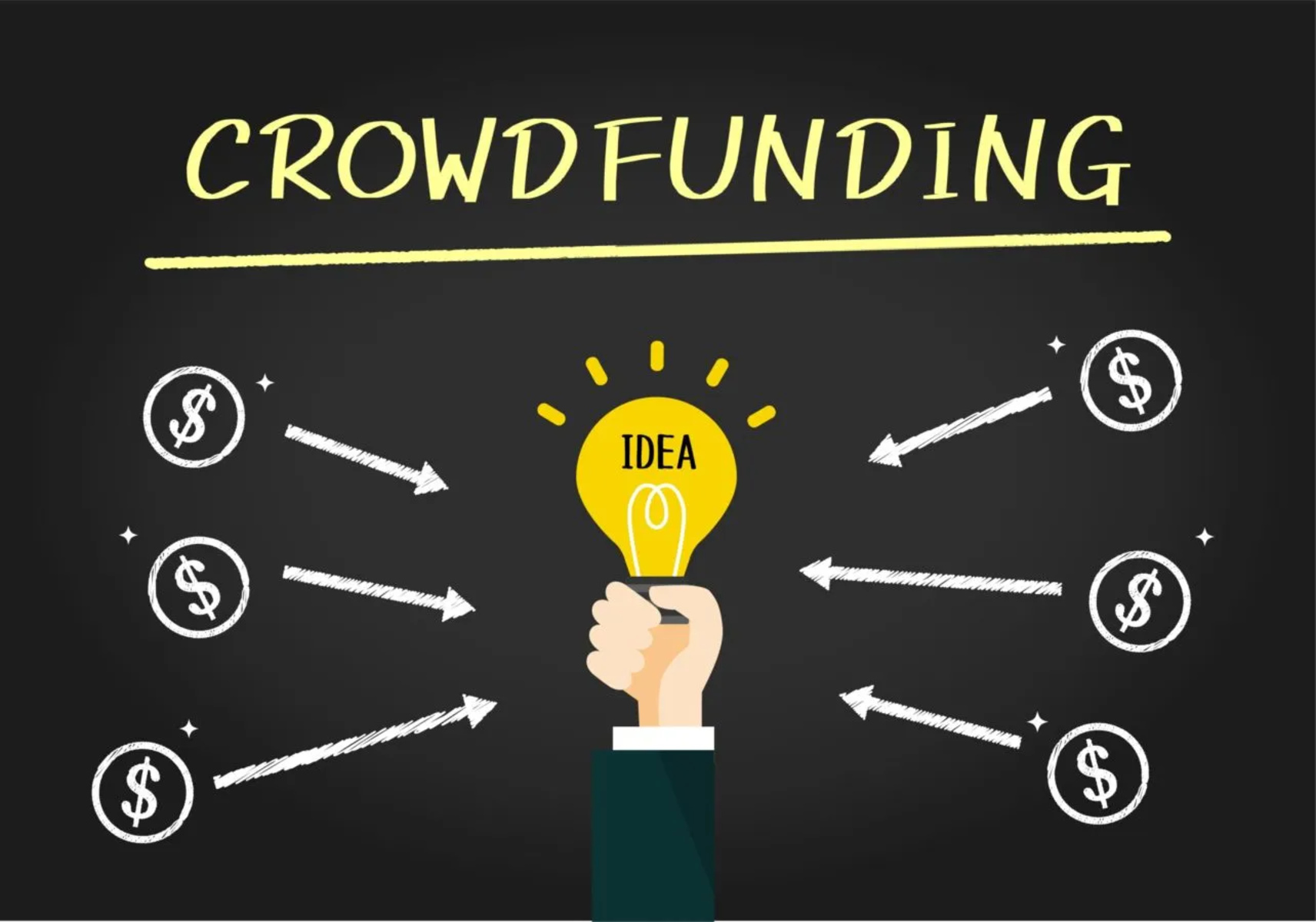Introduction
Welcome to the world of crowdfunding, where individuals, entrepreneurs, and startups have the opportunity to turn their dreams into reality with the support of a community. However, with numerous crowdfunding campaigns vying for attention, it’s essential to find ways to stand out from the crowd. One powerful tool at your disposal is social media. In today’s digital age, social media platforms like Facebook, Twitter, and Instagram have become the epicenter of online engagement.
From raising awareness to garnering support, social media can play a pivotal role in driving the success of your crowdfunding campaign. With billions of users active on these platforms, the potential reach is immense. But gaining a social media following and using it effectively can be a daunting task. However, with the right strategies and tactics, you can attract and engage a dedicated audience who will support and promote your crowdfunding campaign.
In this article, we will explore the importance of social media for crowdfunding, discuss strategies to gain a social media following for your campaign, and provide tips on creating an engaging social media presence. By the end, you will have a deeper understanding of how to harness the power of social media to propel your crowdfunding campaign to success.
Understanding the Importance of Social Media for Crowdfunding
Social media has revolutionized the way we communicate, network, and share information. It has also become a driving force in the world of crowdfunding. The inherent viral nature of social media platforms enables crowdfunding campaigns to quickly gain traction and reach a massive audience. Here’s why social media is crucial for the success of your crowdfunding campaign.
1. Massive Reach: With billions of active users on social media platforms, your campaign has the potential to reach a vast audience across the globe. This reach extends beyond your immediate network, allowing you to tap into new communities and connect with individuals who are passionate about your cause or product.
2. Low-Cost Marketing: Traditional marketing channels can be expensive and often out of reach for startups and individuals who are looking to raise funds. Social media, on the other hand, provides a cost-effective way to promote your campaign and generate buzz. By leveraging organic reach, targeted ads, and influencer partnerships, you can maximize your impact without breaking the bank.
3. Building a Community: One of the key advantages of social media is its ability to facilitate direct engagement and conversation with your audience. By nurturing a community on social media platforms, you can foster a sense of connection, build trust, and establish a loyal following for your crowdfunding campaign. This community can become your brand advocates, spreading the word about your campaign and rallying support.
4. Real-Time Feedback: Social media provides an unparalleled opportunity to gather immediate feedback from your target audience. You can gauge their interest, measure their response to different elements of your campaign, and make necessary adjustments in real-time. This valuable feedback can help you refine your messaging, enhance your offering, and increase the chances of success for your crowdfunding campaign.
5. Leverage Social Proof: People are more likely to contribute to a campaign that others have already supported. Social media allows you to showcase your campaign’s progress, highlight endorsements, and share testimonials from satisfied backers. This social proof can boost credibility and instill confidence in potential supporters, encouraging them to join in and contribute to your crowdfunding campaign.
6. Enhanced Visibility: Social media platforms offer a range of features that can help increase the visibility of your crowdfunding campaign. From trending tags and hashtags to shareable content, you can leverage these tools to amplify your reach and attract new supporters. The viral nature of social media can lead to organic sharing, resulting in increased visibility and potentially attracting a wider audience.
By recognizing the importance of social media for crowdfunding and implementing effective strategies, you can harness the power of these platforms to amplify your campaign’s impact and propel it to success.
Setting Goals for Your Social Media Campaign
Before diving into your social media campaign for crowdfunding, it’s important to establish clear goals. Setting goals not only provides focus but also allows you to measure the success of your efforts. Here are some key considerations when setting goals for your social media campaign.
1. Fundraising Target: Your primary goal is likely to reach and exceed your fundraising target. Start by determining how much funding you need for your campaign. Break down this target into achievable milestones, and use social media to mobilize your audience towards each milestone. Set specific targets for the number of backers, total contributions, or percentage of goal reached through social media campaigns.
2. Audience Growth: Building a social media following is essential for long-term success. Set goals to increase your number of followers and fans across various platforms. Focus on attracting followers who align with your campaign’s target audience, as they are more likely to engage, contribute, and share your content with others.
3. Engagement Metrics: Engagement is a critical metric to assess the effectiveness of your social media campaign. Set goals for metrics such as likes, comments, shares, and retweets. Aim to create content that generates conversations, encourages interaction, and promotes engagement among your audience.
4. Reach and Impressions: Reach and impressions measure the number of people who see your content. Set goals to increase the reach and impressions of your social media posts. Higher reach and impressions mean that your campaign is being exposed to a wider audience, increasing the chances of attracting potential backers.
5. Conversion Rate: Conversion rate measures how many social media engagements translate into actual contributions or support for your campaign. Set goals to improve your conversion rate by optimizing your messaging, call-to-action, and user experience. Aim to increase the percentage of engagements that lead to conversions.
6. Brand Awareness: Establishing a strong brand presence goes hand in hand with a successful social media campaign. Set goals to increase brand awareness by tracking metrics such as mentions, hashtags, and brand searches. Monitor the growth of your brand awareness over time and evaluate the effectiveness of your social media efforts in building your campaign’s brand.
7. Partnerships and Influencer Collaborations: Collaborating with influencers or partnering with complementary brands can help expand your reach and credibility. Set goals to secure a certain number of influencer collaborations or partnerships through social media outreach. Measure the impact of these collaborations on your campaign’s visibility and support.
By setting clear goals for your social media campaign, you can direct your efforts, measure your progress, and make informed adjustments along the way. Remember to regularly track and analyze your social media metrics to ensure you are on the right path to achieving your crowdfunding goals.
Choosing the Right Social Media Platforms
The world of social media is vast, with numerous platforms available for you to choose from. However, not every platform may be suitable for your crowdfunding campaign. It’s important to select the right social media platforms that align with your campaign goals, target audience, and content strategy. Here’s how to choose the right social media platforms for your crowdfunding campaign.
1. Understand Your Target Audience: Start by understanding your target audience and their preferred social media platforms. Conduct research to identify where your audience spends their time online. Consider factors such as demographics, interests, and behaviors. By choosing platforms where your target audience is active, you can effectively reach and engage them.
2. Consider Platform Features: Evaluate the features and functionalities of different social media platforms. Each platform offers unique capabilities, such as visual content on Instagram, professional networking on LinkedIn, real-time updates on Twitter, or community building on Facebook. Choose platforms that allow you to showcase your campaign, create engaging content, and interact with your audience in a way that aligns with your campaign goals.
3. Research Competitor Presence: Investigate the social media presence of your competitors or campaigns similar to yours. Analyze which platforms they are using and how successful they are in engaging their audience. This can provide insights into which platforms are effective in your specific niche and help you make informed decisions about your social media strategy.
4. Consider Content Strategy: Your content strategy plays a key role in determining the appropriate social media platforms for your campaign. If your campaign relies heavily on visual content, platforms like Instagram, Pinterest, or YouTube may be more suitable. If your campaign focuses on news updates or industry insights, Twitter and LinkedIn might be more appropriate. Tailor your platform selection to accommodate your content strategy and maximize its impact.
5. Time and Resource Allocation: Consider the time and resources you have available for managing your social media platforms. Each platform requires consistent and dedicated effort to maintain an active presence. It’s better to have a strong presence on a few platforms rather than spreading yourself too thin on multiple platforms. Choose platforms that you can effectively manage and allocate resources accordingly.
6. Test and Evaluate: Don’t be afraid to experiment and test different social media platforms. Start with a few platforms that you believe are the best fit for your campaign, and monitor their performance. Analyze metrics such as engagement rates, reach, and conversion rates. Based on the results, you can adjust your platform selection and allocate resources accordingly.
Choosing the right social media platforms for your crowdfunding campaign is crucial to reach and engage your target audience effectively. By understanding your audience, evaluating platform features, researching competitors, considering your content strategy, and allocating resources wisely, you can make informed decisions and maximize the impact of your social media efforts.
Creating a Compelling Social Media Strategy
A compelling social media strategy is essential for attracting and engaging your audience, driving support for your crowdfunding campaign, and achieving your goals. Here are key steps to create an effective social media strategy for your campaign.
1. Define Your Objectives: Start by clearly defining your social media objectives. What do you want to achieve through your social media presence? Is it to generate awareness, drive traffic to your crowdfunding page, or encourage user-generated content? By defining your objectives, you can align your strategy and tactics accordingly.
2. Know Your Target Audience: Understanding your target audience is crucial for tailoring your social media strategy. Research their demographics, interests, preferences, and pain points. This insight will help you create relevant content and determine the best ways to engage with your audience.
3. Craft Your Brand Persona: Build a consistent brand persona that resonates with your target audience. Determine your brand’s tone of voice, values, and messaging. A compelling brand persona creates authenticity and helps in establishing a strong connection with your audience.
4. Plan Your Content Strategy: Develop a content strategy that aligns with your campaign goals and resonates with your target audience. Determine the types of content you will create, such as educational posts, behind-the-scenes sneak peeks, user stories, or campaign updates. Plan a content calendar to ensure consistency and timeliness.
5. Utilize Content Formats: Explore different content formats to keep your social media presence engaging and diverse. Experiment with images, videos, infographics, GIFs, live streams, or interactive polls. A mix of content formats will capture attention, encourage sharing, and enhance the overall user experience.
6. Develop a Posting Schedule: Consistency is key on social media. Create a posting schedule that includes the ideal frequency and timing for your posts. Find the balance between providing regular updates and avoiding overwhelming your audience with excessive content.
7. Engage and Interact: Social media is about fostering conversations and building relationships. Engage with your audience by responding promptly to comments, messages, and mentions. Encourage dialogue, ask questions, and show appreciation for your supporters. Interacting with your audience creates a sense of community and strengthens their connection with your campaign.
8. Utilize Hashtags: Hashtags can significantly increase the visibility of your social media content and attract a wider audience. Research and utilize relevant hashtags that are popular in your niche or related to your campaign. Incorporate them strategically into your posts to increase discoverability and engagement.
9. Monitor and Analyze: Regularly monitor and analyze your social media performance using metrics and analytics tools. Identify what content performs well, which platforms drive the most engagement, and how your audience responds to different tactics. This data-driven approach allows you to optimize your strategy and make informed decisions to improve your campaign’s results.
10. Stay Up-to-Date: Social media platforms and trends are constantly evolving. Stay current with platform updates, algorithm changes, and emerging trends in social media marketing. Adapt your strategy accordingly to leverage new opportunities and maintain a competitive edge.
By following these steps and continuously refining your strategy, you can create a compelling social media presence that effectively promotes your crowdfunding campaign, engages your audience, and enhances your chances of success.
Building an Engaging Brand Presence
A strong and engaging brand presence on social media is crucial for driving support and generating excitement for your crowdfunding campaign. It helps you establish credibility, connect with your audience, and differentiate yourself from competitors. Here are key strategies to build an engaging brand presence on social media.
1. Consistent Visual Identity: Develop a consistent visual identity that reflects your brand and campaign. Use a cohesive color scheme, typography, and logo across your social media profiles. Consistency creates recognition and helps your audience associate your visuals with your campaign.
2. Compelling Brand Story: Craft a compelling brand story that resonates with your audience. Give them a reason to connect with your campaign on a personal level. Share the inspiration behind your project, the challenges you’ve overcome, and the impact you aim to make. Your brand story should evoke emotion and create a sense of purpose.
3. Engaging Content: Create content that grabs attention, sparks interest, and encourages interaction. Use a mix of informative, entertaining, and inspirational content that aligns with your campaign’s messaging and values. Leverage storytelling techniques to connect with your audience emotionally and make your brand relatable.
4. User-Generated Content (UGC): Encourage your audience to create and share their own content related to your campaign. User-generated content not only adds authenticity but also boosts engagement and trust. Share UGC on your social media platforms, showcasing the impact of your campaign and the enthusiasm of your supporters.
5. Creative Contests and Giveaways: Organize contests and giveaways to promote engagement and excitement. Encourage your audience to participate by liking, sharing, and commenting on your posts, as well as tagging their friends. This builds excitement and expands the reach of your campaign. Offer incentives related to your campaign, such as exclusive merchandise or early access to your product.
6. Live Video Streaming: Utilize live video streaming features on platforms such as Facebook, Instagram, or YouTube. Host live Q&A sessions, behind-the-scenes tours, or product demonstrations. Live videos create an interactive and immersive experience, allowing your audience to connect with you in real-time and ask questions.
7. Influencer Partnerships: Collaborate with influencers or industry experts who align with your campaign’s values and target audience. Their endorsement and support can help raise awareness, increase credibility, and attract new supporters. Choose influencers with an engaged and relevant following to maximize the impact of your partnership.
8. Social Listening: Actively listen and respond to your audience on social media. Monitor mentions, comments, and direct messages to engage in conversations, address concerns, and show appreciation. This demonstrates that you value your audience’s input and builds a community around your brand.
9. Authenticity and Transparency: Be authentic and transparent in your social media communications. Share updates on your campaign’s progress, milestones, and challenges. Engage in open and honest conversations with your audience. Authenticity builds trust and fosters a genuine connection with your supporters.
10. Data Analysis: Analyze your social media performance using analytics tools to gain insights into what content resonates with your audience. Identify trends, preferences, and engagement patterns. Use this data to refine your content strategy and optimize your brand presence on social media.
By implementing these strategies, you can build an engaging brand presence on social media that captures attention, fosters connection, and drives support for your crowdfunding campaign.
Utilizing Visual Content to Capture Attention
In the fast-paced world of social media, captivating visuals are essential to grab attention and make a memorable impression. Visual content has the power to engage your audience, evoke emotions, and convey your campaign’s message effectively. Here’s how to utilize visual content to capture attention on social media.
1. Compelling Images: High-quality, visually appealing images are a must-have for your social media posts. Use eye-catching graphics, professional product photos, or powerful photographs that relate to your campaign. Images should be relevant, tell a story, and evoke an emotional response from your audience.
2. Infographics: Infographics are a fantastic way to present complex information in a visually appealing and digestible format. Use them to highlight key statistics, product features, or campaign milestones. Infographics simplify information and make it shareable, increasing the reach and impact of your message.
3. Engaging Videos: Video content has become increasingly popular on social media. Create engaging videos that explain your campaign, showcase your product, or share updates. Keep videos concise, visually captivating, and focus on telling a compelling story. Use captions or subtitles to make them accessible to a wider audience.
4. Live Streams and Stories: Utilize the live streaming features of platforms like Facebook, Instagram, or YouTube to engage your audience in real-time. Host live Q&A sessions, behind-the-scenes tours, or product demonstrations. Stories on platforms like Instagram and Snapchat offer a more casual and authentic way to connect with your audience through visual snippets that disappear after 24 hours.
5. Visual Quotes: Use visually appealing quote images to share inspiring messages, campaign testimonials, or words of encouragement. Overlay meaningful quotes on captivating backgrounds or images related to your campaign. Visual quotes are highly shareable and can have a profound impact on your audience.
6. Interactive Visuals: Interactive visuals, such as quizzes, polls, or interactive infographics, encourage active participation from your audience. These visuals not only capture attention but also create an engaging and interactive experience. Interactive content prompts your audience to spend more time with your campaign and encourages them to share their experiences with others.
7. User-Generated Content: Leverage user-generated content to showcase the impact and authenticity of your campaign. Encourage your audience to share their photos, videos, or stories related to your campaign. Repost and share this user-generated content on your social media platforms to demonstrate the real-life experiences and connections your campaign has created.
8. Visual Consistency: Maintain visual consistency across your social media platforms to create a cohesive and recognizable brand identity. Use consistent colors, fonts, and themes that align with your campaign. This consistency builds brand recognition, strengthens your visual identity, and helps your content stand out in a crowded social media landscape.
9. Compelling Thumbnails: Pay attention to thumbnails when posting videos or sharing links. Thumbnails act as the visual preview of your content and play a significant role in capturing attention. Choose visually compelling and relevant thumbnails that entice your audience to click and engage with your content.
10. Data Visualization: If your campaign relies on data or numbers, consider using data visualization techniques to make the information more engaging. Utilize charts, graphs, or diagrams to present your data in a visually appealing and memorable way. Data visualization can simplify complex information and make it more accessible to your audience.
Utilizing visual content effectively on social media can significantly impact the success of your crowdfunding campaign. By incorporating compelling images, engaging videos, infographics, interactive visuals, and leveraging user-generated content, you can capture attention, evoke emotions, and leave a lasting impression on your audience.
Increasing Engagement Through User-Generated Content
User-generated content (UGC) is a powerful tool for increasing engagement and building a sense of community around your crowdfunding campaign. By encouraging your audience to create and share their own content related to your campaign, you can foster a deeper connection, boost trust, and expand the reach of your message. Here’s how to increase engagement through user-generated content on social media.
1. Establish Clear Guidelines: Provide clear guidelines and instructions for creating and sharing user-generated content. Specify the type of content you’re looking for, such as photos, videos, testimonials, or stories. Set guidelines for quality, length, and appropriate use of brand-related elements. This ensures that the content aligns with your campaign’s messaging and resonates with your audience.
2. Incentivize Participation: Offer incentives to motivate your audience to create and share user-generated content. Consider running contests, giveaways, or challenges that reward participants for their contribution. Offer exclusive campaign merchandise, early access to your product, or shoutouts in your social media posts as incentives. The allure of rewards can encourage more engagement and generate a sense of excitement around your campaign.
3. Create a Hashtag Campaign: Develop a unique and memorable hashtag for your campaign and encourage your audience to use it when sharing their content. Hashtags amplify the visibility and discoverability of user-generated content, as well as create a centralized hub for everything related to your campaign. Promote the hashtag across your social media platforms, website, and campaign materials to ensure maximum participation.
4. Showcase UGC: Share the user-generated content you receive on your social media platforms. Reposting and sharing UGC not only acknowledges the efforts of your audience but also amplifies their voices and experiences. This creates a sense of community and gives your backers the opportunity to be recognized and celebrated. Highlighting UGC builds trust and encourages others to participate.
5. Engage and Respond: Actively engage with the user-generated content by liking, commenting, and sharing it. Show appreciation for the efforts of your audience and respond to their content. Engaging with UGC demonstrates that you value their contributions and fosters an ongoing relationship with your supporters. It also encourages others to participate, knowing that their content will be acknowledged.
6. Collaborate with Influencers: Partner with influencers or industry experts who align with your campaign and have an engaged following. Collaborating with influencers can extend the reach of your user-generated content, as their followers are more likely to participate when prompted by the influencers they trust. These partnerships can bring new perspectives, credibility, and a wider audience to your UGC campaign.
7. Provide Inspiration and Prompts: Inspire your audience to create user-generated content by providing prompts, themes, or challenges. Encourage them to share their personal stories, experiences, or ideas related to your campaign. This helps to guide their content creation process and stimulates their creativity. Use your social media platforms to share examples, testimonials, or testimonials that inspire and encourage participation.
8. Share UGC Across Multiple Channels: Extend the reach of user-generated content by sharing it across multiple social media channels and platforms. Repurpose UGC in blog posts, email newsletters, or even offline marketing materials. This multi-channel approach ensures that your audience encounters the user-generated content in various contexts, increasing engagement and generating further interest in your campaign.
9. Foster a Community: Use user-generated content to foster a sense of community around your campaign. Encourage participants to connect and engage with each other, fostering conversations and relationships. Facilitate discussions and provide platforms for supporters to share their experiences and connect on a deeper level. A strong community creates a supportive environment and can become a driving force behind your campaign’s success.
10. Express Gratitude: Show genuine appreciation for the user-generated content you receive. Thank and acknowledge your audience through personalized responses, public shoutouts, or even small gifts or rewards. Expressing gratitude strengthens the bond with your supporters and encourages them to continue participating in your campaign.
By implementing these strategies, you can leverage the power of user-generated content to increase engagement, foster a sense of community, and propel the success of your crowdfunding campaign.
Leveraging Influencers and Partnerships
Leveraging influencers and partnerships can significantly boost the visibility and credibility of your crowdfunding campaign. Collaborating with influencers – individuals with a significant following and influence in your target market – and forging strategic partnerships with like-minded brands can expand your reach, build trust, and drive more support for your campaign. Here’s how to leverage influencers and partnerships effectively.
1. Identify Relevant Influencers: Research and identify influencers who align with your campaign’s values, target audience, and niche. Look for influencers who have a genuine interest in your industry or cause and actively engage with their followers. Consider factors like their reach, engagement rate, and previous collaborations to ensure they are a good fit for your campaign.
2. Build Authentic Relationships: Take the time to establish authentic relationships with influencers and show genuine interest in their work. Engage with their content, share their posts, and leave thoughtful comments. Forming a genuine connection before reaching out for collaboration creates a solid foundation for a successful partnership.
3. Plan a Mutual Value Exchange: Approach influencers and brands with a clear value proposition. Show them how partnering with your campaign will benefit them and their audience. Offer unique content, exclusive access, or other incentives that align with their interests and goals. Be prepared to negotiate and find a mutually beneficial arrangement.
4. Collaborate on Content Creation: Collaborate with influencers and brands on creating compelling content that promotes your campaign. This could include sponsored posts, influencer takeovers, or co-created videos. Involve them in the storytelling process and encourage their creative input. By partnering closely on content creation, you can tap into their expertise and establish a strong connection with their audience.
5. Leverage Influencer Reach: Capitalize on the wide reach of influencers by encouraging them to share your campaign with their followers. Influencers can promote your campaign through dedicated posts, stories, or live streams. Their endorsement and engagement can drive new followers and potential backers to your campaign.
6. Engage in Affiliate Partnerships: Consider forming affiliate partnerships with influencers or brands where they receive a commission for each referral or conversion they generate for your campaign. Affiliate partnerships provide an incentive for influencers and brands to actively promote your campaign and can help drive significant traffic and support.
7. Participate in Guest Blogging: Collaborate with influencers or brands to create guest blogging opportunities. Write guest posts for their blogs or invite them to contribute to your campaign’s blog. Guest blogging allows you to tap into their audience and establish yourself as an expert in your field, enhancing the credibility and visibility of your campaign.
8. Host Cross-Promotions: Partner with complementary brands or campaigns to host cross-promotions. This involves promoting each other’s campaigns or products to your respective audiences. Cross-promotions can expand your reach to new and relevant audiences, driving more support and engagement for both parties involved.
9. Offer Influencers Exclusive Benefits: Provide influencers with exclusive incentives or benefits for being part of your campaign. This could include access to pre-launch previews, early bird offers, or personalized rewards. Exclusive benefits make influencers feel appreciated and increase their motivation to actively support and promote your campaign.
10. Monitor and Measure the Results: Regularly track the results of your influencer collaborations and partnerships. Analyze metrics such as engagement, website traffic, conversion rates, and social media reach. Adjust your strategy based on the insights gathered to optimize your collaborations and achieve the best possible results.
By leveraging influencers and partnerships effectively, you can tap into their networks, increase your campaign’s visibility, and build credibility with your audience. Choose influencers and brands that align with your campaign’s values and goals, and nurture authentic relationships that will benefit both parties involved.
Implementing Effective Hashtag Strategies
Hashtags play a crucial role in increasing the discoverability, engagement, and reach of your social media content. When implemented effectively, hashtags can help your crowdfunding campaign gain visibility and attract a wider audience. Here are key strategies to implement effective hashtag strategies for your campaign.
1. Research Relevant Hashtags: Start by researching and identifying relevant hashtags that are commonly used in your industry or niche. Look for hashtags that resonate with your campaign’s message, target audience, and goals. Analyze the popularity and engagement of these hashtags to ensure they will effectively reach your desired audience.
2. Create a Branded Hashtag: Develop a unique and memorable hashtag specifically for your campaign. A branded hashtag can help unify your content and create a community around your campaign. Make sure your branded hashtag is easy to remember, relevant to your campaign, and encourages user participation.
3. Utilize Trending Hashtags: Keep an eye on trending hashtags that relate to your campaign or industry. When appropriate, incorporate these trending hashtags into your posts to increase the visibility of your content and tap into the larger conversations happening on social media. This can attract new followers and potential backers.
4. Mix Popular and Niche Hashtags: Strike a balance between using popular hashtags and niche-specific hashtags. Popular hashtags can expose your content to a larger audience, while niche hashtags allow you to target and engage with a more specific audience who are interested in your campaign. Use a combination of both to maximize reach and relevancy.
5. Don’t Overdo It: While it’s important to use hashtags strategically, it’s equally crucial not to overuse them. Limit the number of hashtags in your posts to maintain readability and avoid appearing spammy. Aim for a maximum of 2-3 relevant and focused hashtags per post. Quality and relevancy are more important than quantity.
6. Research Campaign-Specific Hashtags: Explore hashtags that are specific to crowdfunding or your campaign’s cause. Look for hashtags that potential supporters or backers might be using when seeking out campaigns to support. By including these campaign-specific hashtags, you can increase the chance of attracting individuals who are passionate about crowdfunding or your specific cause.
7. Promote Hashtags Offline: Extend the reach of your hashtags beyond social media by promoting them offline. Include your campaign’s hashtag on physical marketing materials such as flyers, posters, business cards, or even merchandise. Encourage people to use the hashtag when sharing their experiences with your campaign, attending your events, or pledging their support.
8. Engage with Hashtag Conversations: Monitor hashtag conversations related to your campaign and actively engage with them. Like, comment, and share posts that use relevant hashtags to join the ongoing discussions and build relationships with potential backers. Engaging with hashtag conversations increases your visibility and positions your campaign as an active participant in the community.
9. Create Hashtag Challenges: Spark engagement by creating hashtag challenges that encourage your audience to create and share their own content related to your campaign. Provide a clear prompt or theme and ask participants to include your campaign’s hashtag. This fosters user-generated content, boosts visibility, and generates excitement among your audience.
10. Monitor and Analyze: Regularly monitor and analyze the performance of your hashtags using social media analytics tools. Identify which hashtags generate the most engagement, reach, and conversions. Use these insights to adjust your hashtag strategy, capitalize on successful hashtags, and optimize your campaign’s visibility.
By implementing effective hashtag strategies, you can increase the discoverability, engagement, and reach of your social media content. Choose relevant and focused hashtags, create a branded hashtag, participate in conversations, and encourage user participation to maximize the impact of your campaign.
Interacting and Responding to Your Audience
Interacting and responding to your audience is a crucial aspect of building a strong and engaged community around your crowdfunding campaign. By actively engaging with your audience on social media, you can establish relationships, address concerns, and foster a sense of connection. Here are key strategies for effectively interacting and responding to your audience.
1. Respond Promptly: Timely responses show your audience that you value their input. Aim to respond to comments, direct messages, and mentions as promptly as possible. Prompt responses demonstrate your commitment to engaging with your audience and can help build trust and loyalty.
2. Be Authentic and Personable: Respond to your audience in an authentic and personable manner. Use a friendly and conversational tone that aligns with your brand persona. Show genuine interest in their comments or questions and provide thoughtful and helpful responses. Personalized interactions can make your audience feel valued and appreciated.
3. Address Concerns and Questions: Actively listen and address any concerns or questions raised by your audience. Respond professionally and provide accurate and helpful information. Be transparent and honest in your responses, even if the answer may not be what they expected. Addressing concerns promptly can help resolve issues, build trust, and maintain a positive reputation.
4. Show Appreciation: Express gratitude for the support, feedback, and engagement received from your audience. Use social media platforms to publicly thank individuals who have contributed, shared your content, or actively participated in discussions. Showing appreciation fosters a positive and supportive atmosphere.
5. Ask Questions and Encourage Discussion: Encourage your audience to share their thoughts and opinions by asking questions or starting discussions. Prompt them to share their experiences, ideas, or suggestions related to your campaign. Engaging in meaningful conversations with your audience not only strengthens your relationship but also provides valuable insights and ideas for your campaign.
6. Monitor and Moderate: Regularly monitor your social media platforms for any inappropriate or spammy content. Promptly remove or hide such content to maintain a positive and safe environment for your audience. Set clear guidelines for acceptable behavior and communicate them to your community.
7. Use Humor or Creativity: Inject humor or creativity into your interactions when appropriate. Clever or lighthearted responses can help humanize your brand and create a more engaging and enjoyable experience for your audience. However, be mindful of the tone and context to ensure your humor aligns with your brand image and campaign message.
8. Engage in Social Listening: Actively listen to conversations and mentions related to your campaign, even if you aren’t directly tagged. Monitor hashtags, industry keywords, or mentions of your brand to discover opportunities for engagement. Like, share, or comment on relevant posts to show your presence and interest in the community.
9. Encourage User-Generated Content: Prompt your audience to create and share their own content related to your campaign. Acknowledge and share this user-generated content on your social media platforms, showcasing the creativity and enthusiasm of your audience. This not only strengthens the relationship with your supporters but also encourages more engagement from others.
10. Take Feedback into Consideration: Listen and take feedback from your audience seriously. Analyze their suggestions, comments, and constructive criticism. Use this feedback to improve your campaign, content strategy, or any areas that need refinement. Responding positively to feedback shows that you value your audience’s input and are committed to delivering a better experience.
By interacting and responding to your audience on social media, you can foster a sense of community, build trust, and create a positive environment for your crowdfunding campaign. Regularly engage with your audience, provide thoughtful responses, and actively listen to their feedback to establish a strong and engaged supporter base.
Analyzing and Optimizing Your Social Media Campaign
Analyzing and optimizing your social media campaign is crucial to ensure its effectiveness and maximize your crowdfunding success. By continuously monitoring and analyzing your campaign’s performance, you can identify areas for improvement, refine your strategy, and ultimately achieve better results. Here are key steps to analyze and optimize your social media campaign.
1. Set Clear Metrics: Define the metrics that align with your campaign goals. These metrics could include engagement rate, reach, conversion rate, click-through rate, or the number of backers directly attributed to social media. Setting clear and specific metrics allows you to measure the success of your campaign accurately.
2. Monitor Key Performance Indicators (KPIs): Regularly monitor your campaign’s KPIs to assess its performance. Use social media analytics tools to track metrics such as follower growth, engagement levels, website traffic from social media, or campaign-specific metrics. Analyze trends and patterns to gain insights into what’s working and what can be improved.
3. Test and Experiment: Experiment with different content styles, posting frequencies, hashtags, and platforms to see what resonates best with your audience and drives the most engagement. A/B testing can help identify which content elements are more effective and allow you to optimize your strategy accordingly.
4. Analyze Audience Insights: Use the analytics provided by social media platforms to understand your audience better. Analyze demographics, interests, online behaviors, and preferences to tailor your content and messaging. By understanding your audience, you can create more relevant and engaging content that speaks directly to their needs and desires.
5. Track Referral traffic: Use web analytics tools to track and analyze the traffic driven by your social media campaigns. Identify which social media platforms are generating the most website visits and conversions. Focus your efforts on those channels and optimize your content for better results.
6. Identify Top-performing Content: Analyze your social media posts to identify the content that performs the best in terms of engagement, reach, and conversions. Look for patterns or themes that resonate with your audience. Replicate and expand upon successful content to maximize your reach and impact.
7. Understand Conversion Funnels: Map out the user journey from social media engagement to conversion. Identify the touchpoints or actions that lead to conversions, such as clicking on a campaign link, signing up for a newsletter, or making a contribution. Optimize these touchpoints to enhance the conversion rate and streamline the user experience.
8. Stay Up-to-Date with Algorithm Changes: Social media algorithms constantly evolve, affecting the reach and visibility of your content. Stay informed about algorithm updates and adjust your strategy accordingly. Stay updated on best practices for each platform to ensure your content is effectively reaching your intended audience.
9. Learn from Competitors: Monitor the social media activities of your competitors or similar crowdfunding campaigns. Analyze their strategies, content types, and engagement levels. Identify what works well for them and adapt those learnings to your own campaign. Stay innovative and find unique ways to differentiate yourself.
10. Iterate and Refine: Regularly review your analytics, metrics, and insights to make data-driven decisions. Identify areas where you can make improvements, adjust your strategy, and measure the impact of those changes. Continuously iterate, refine, and optimize your social media campaign based on data and insights gathered along the way.
By analyzing and optimizing your social media campaign, you can fine-tune your strategy, enhance engagement, and drive better results. Regularly monitor your campaign’s performance, experiment with different approaches, and stay informed about industry trends to ensure that your campaign is on the path to success.
Conclusion
Building a solid social media presence is essential for the success of your crowdfunding campaign. By implementing the strategies and tactics outlined in this article, you can gain a social media following that will not only support your campaign but also amplify its reach. Remember to set clear goals, choose the right social media platforms, create compelling content, and engage with your audience authentically.
Understand the importance of social media for crowdfunding and the immense potential it holds in reaching a wide audience. Utilize visual content to capture attention, leverage user-generated content to foster a sense of community, and collaborate with influencers and strategic partners to widen your campaign’s reach.
Implement effective hashtag strategies to increase the discoverability of your content and engage in meaningful interactions with your audience. Regularly analyze the performance of your social media campaign, optimize based on data insights, and strive for continuous improvement.
Remember, building a successful social media presence takes time, effort, and continuous monitoring. Stay up-to-date with social media trends and adapt your strategies accordingly. By consistently delivering valuable, engaging, and authentic content, you can generate excitement, build trust, and drive support for your crowdfunding campaign.
Now, armed with the knowledge and strategies outlined in this article, go forth and harness the power of social media to propel your crowdfunding campaign to new heights.

























